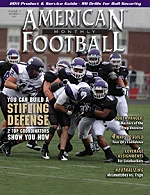Article CategoriesAFM Magazine
|
Stifle Your Opponent with a Bruising Defense – Coordinators of two top-ranked college defenses show you how.© More from this issueWhat are the most important ingredients of a stifling defense? Beyond having a sound scheme, what should coaches look for in athletes in an effort to ensure domination of their opponents? To get the answers, AFM talked to the defensive coordinators of two of 2010’s most imposing defensive units – Mount Union of Division III and Boston College of the FBS. While certain defensive fundamentals are to be expected, both Vince Kehres of Mount Union and Bill McGovern of BC provided additional insight into qualities and techniques that can go a long way toward creating smothering defensive units. Consider the following about the Mount Union defense in 2010. The Purple Raiders led the nation in scoring defense, giving up only 8.9 points per game. In the process, they held five opponents scoreless and, in one stretch, limited the oppositio....The full article can only be seen by subscribers.
|
|
|||||||
| HOME |
MAGAZINE |
SUBSCRIBE | ONLINE COLUMNISTS | COACHING VIDEOS |
Copyright 2025, AmericanFootballMonthly.com
All Rights Reserved





